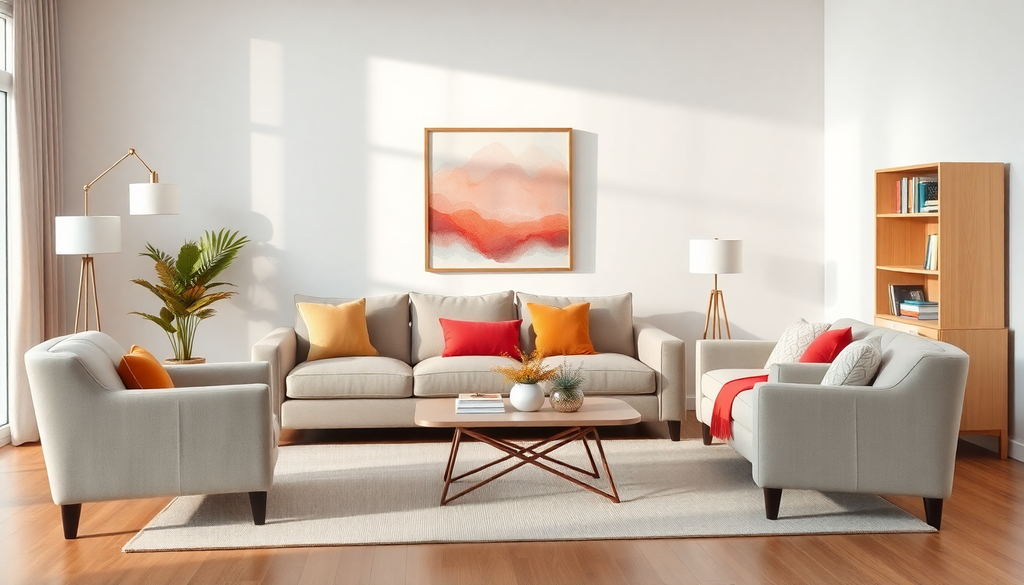Mix large and small furniture pieces to achieve visual balance in a room

Why Visual Balance Matters in Room Design
A visually balanced room feels like a deep breath—it’s natural, calming, and effortlessly functional. When done well, it prevents a space from feeling overwhelming or underwhelming. The secret lies in understanding visual weight, which is influenced by the size, shape, color, and texture of each piece of furniture. Here's how to achieve balance and why it matters:
What is Visual Weight?
Think of each piece of furniture as carrying an invisible presence. Visual weight determines how "heavy" or "light" an item appears in a space. For example:
- Large, hefty furniture (e.g., a sectional sofa) acts as the backbone of the room, giving it stability and grounding.
- Smaller items (e.g., accent chairs, side tables, decor) provide movement and detail, creating connections between larger focal points.
The Impact of Ignoring Balance
When balance is neglected, it creates a sense of disorder:
- A too-heavy space can feel claustrophobic and overwhelming.
- A too-light space may feel sparse and unfinished, lacking warmth or personality.
How to Create Flow and Harmony
Achieving visual balance requires a thoughtful mix of large and small pieces. Consider this analogy:
- Large pieces are like the deep bassline in music—they set the rhythm and ground the space.
- Smaller pieces are the notes and melodies that layer on top, adding depth and harmony.
By mixing these elements, you create a cohesive flow that feels natural and energizing.
Emotional Benefits of Balance
A well-balanced room invites you to stay, exhale, and relax. When everything feels in its right place, the space becomes functional and purposeful. Balance isn’t just visual—it’s emotional. It sets the tone for an environment that promotes comfort, focus, and enjoyment.
In essence: Balance transforms a room from a collection of objects into a meaningful, unified space.
Key Components of Visual Balance
Achieving visual balance hinges on understanding how different elements work together to create harmony. At its core, it’s about distributing "visual weight" in a way that feels intentional, not accidental. Here’s how you can break it down:
Visual Weight
Everything in a room carries a certain weight, visually speaking. A chunky leather armchair has a lot more presence than a slender-legged side table, even if it occupies the same square footage. The key is to identify where these heavy and light anchors are in your space. If one side of the room feels like it’s sinking under the weight of a massive sectional, counterbalance it by layering lighter pieces on the opposite side—like an airy bookcase, a pair of accent chairs, or a cluster of plants. The goal isn’t symmetry; it’s balance. Think of it like a seesaw, but for your eyes.
Symmetry vs. Asymmetry
Balance doesn’t always mean matching. Symmetry works great when you want a room to feel formal or structured—like identical nightstands on either side of a bed. But if you’re aiming for something more relaxed (or if your room layout just doesn’t play nice with symmetry), asymmetry is your friend. Offset a statement piece—like that heavy credenza—with a grouping of smaller items on the other side, such as a floor lamp and an accent chair. Done right, asymmetrical balance feels dynamic and lived-in without veering into chaos. It’s informal but not careless.
Practical Tips for Mixing Large and Small Furniture Pieces
Achieving balance in a room requires thoughtful placement of large and small furniture pieces. Think of your space as a canvas where large pieces are the bold strokes that define structure, while smaller items add personality and detail. Here’s a guide to help you get the mix just right.
Step 1: Plan Your Layout
A balanced room layout begins with intention, not guesswork.
-
Start with large furniture: Identify dominant pieces (e.g., sofa, bed, dining table) and decide on their placement.
- Example: In your living room, the couch serves as the anchor. Position it to command attention without overwhelming the space.
- Layer smaller items afterward: Add smaller pieces like side tables, ottomans, or accent chairs to harmonize with the larger items and complement the overall flow.
💡 Pro Tip: Sketch a quick floor plan or use online design tools to visualize your layout before moving any furniture.
Step 2: Mind Scale and Proportion
Matching furniture size to the dimensions of your space is crucial to avoid imbalance.
-
Small rooms and large furniture: It’s okay to include larger pieces in smaller spaces, but compensate with minimalism. For example:
- An oversized armchair can work if it’s paired with low-profile side furniture and enough empty space around it.
- Large rooms and small furniture: Avoid scattering tiny items across big, open areas. Instead, group them into defined clusters to create a sense of cohesion.
⚖️ Balance Tip: Use your room's size as a guide for selecting the heft and proportion of each furniture piece, rather than blindly following trends.
Step 3: Group Small Furniture Thoughtfully
Small furniture and accessories gain purpose when arranged with intention.
-
Avoid the "sad single": A lone chair or table can feel disconnected. Instead, group items to create cohesive, functional zones:
- Pair two small chairs with a slim side table for a cozy conversation nook.
- Place a coffee table with a sofa and a bold area rug to establish a central focal point.
- Embrace odd numbers: Odd-numbered groupings, such as three staggered photo frames or five stacked books, tend to look more natural and visually appealing.
🎨 Design Tip: Clusters prevent small items from seeming like afterthoughts and give them visual weight within the room.
Step 4: Vary Heights and Levels
Flat, uniform furniture placement can make a space look dull and lifeless.
-
Create vertical interest: Use varying heights to add dimension and keep the eye moving through the space. For example:
- A sideboard adorned with a tall vase, a medium-height table lamp, and a small stack of books creates visual variety.
- A tall plant placed near a low coffee table brings energy and contrast to the setup.
- Avoid "flatlining": Maintain a mix of furniture and decor at different levels throughout the room to create layers and depth.
🌿 Elevate the Room: Incorporate vertical elements like standing mirrors or floor lamps to break up horizontal monotony.
Final Thoughts: Trust Your Instincts
Mixing large and small furniture might seem tricky at first, but with attention to proportion, grouping, and height variation, it quickly becomes intuitive. Remember:
- Your space doesn’t need to resemble a showroom.
- The goal is to create a room that feels balanced and works for you.
Experiment, iterate, and trust your personal taste—after all, the best designs are those that reflect your unique style.

